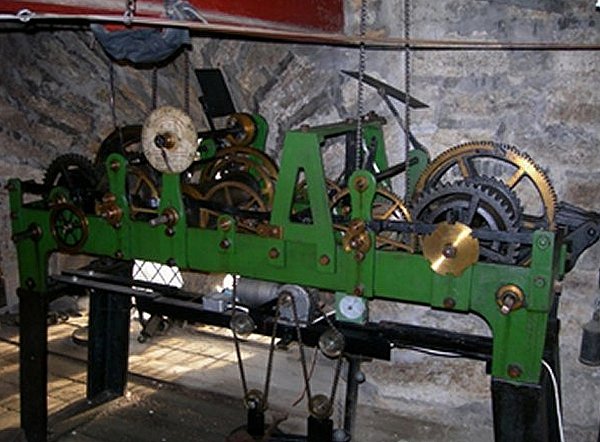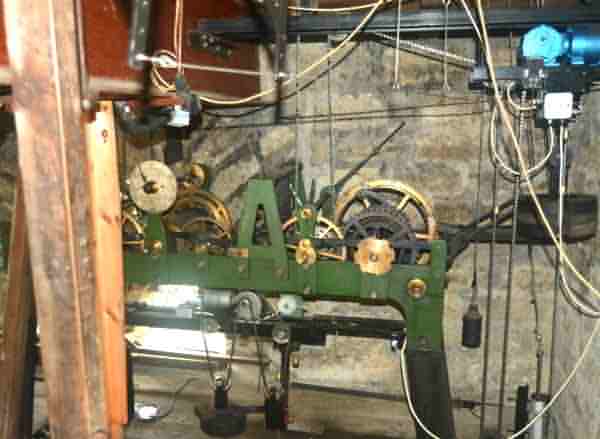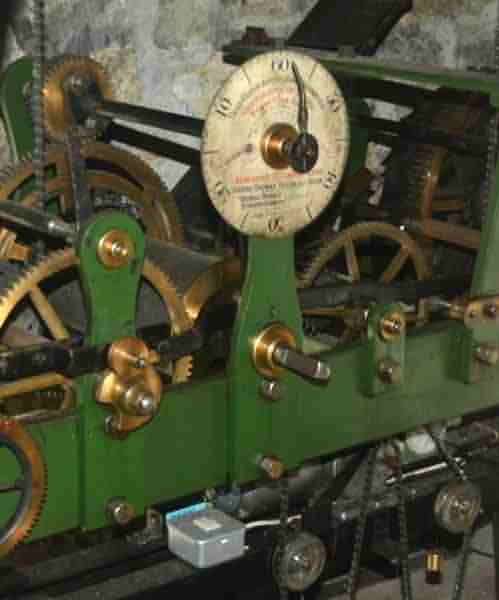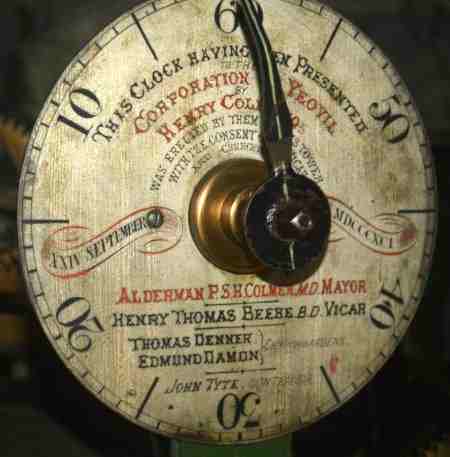St John's Tower clock
St John's church Tower clock
Telling the time to Yeovil
It appears that there have been clocks installed in St John's church for centuries. For instance, in 1694 a payment of one shilling was paid to "John Hellyar for mendinge the Clock" was recorded in the Churchwardens' Accounts. There were frequent payments for items such as oil for the clock, new ropes for the clock's chimes as well as regular maintenance and occasional adjustments. There are few details of these early clocks but they are assumed to have been faceless and informed the time by means of chimes.
In June 1849 the new Town Hall in High Street was officially opened. It had been intended that a public clock would be installed atop the new building, although initially it was surmounted by a cornice with a circular opening intended for a clock, which was installed later in 1863. During 1864, the clock weights fell through the town hall ceiling. One of the weights became embedded in the dance floor, while the other, heavier, weight burst through the floor and became lodged in the ceiling of the market below. In 1865, concerns were raised concerning the structural instability of the clock tower. Other reports recalled issues, such as the clock movement stopping due to the weight of snow on the hands and high winds smashing the dials. By 1887 surveyors declared the clock structure unsafe, blaming poor design and unsatisfactory materials and the clock tower was taken down in 1887. The town hall clock tower was replaced in 1912 with a new steel structure that was designed to evenly distribute the great weight of the clock tower, its gas-illuminated clock and the heavy bells.
In its edition of 30 April 1891, the Devon & Exeter Daily Gazette reported "A very sensible proposal is made which, if carried out, will obviate the necessity of expending a large sum of money in erecting a tower in the borough of Yeovil for the reception of a public clock and chimes. As the church tower is now in course of restoration, and the bells will be put in thorough order, it is suggested that clock works should be placed within the tower and that the bells should be utilised for the purpose of striking the quarters and giving the Westminster chimes. The handsome church tower would not be defaced by placing the dial of a clock there, but four dials to a non-striking clock would be erected in place thereof in a lightly constructed turret over the market house. This would point to the minutes and hours as they fly by, and as both clocks would be under the control of the same person the chimes in the tower would respond to the hands of the clock over the market house. If this arrangement be carried out it will save a sum of public money and should give satisfaction all round.”
In response, on 24 September 1891 Yeovil Borough Council installed a chiming clock (as opposed to a 'timepiece' which is a clock with no bell, or a 'striking clock' which just strikes on the hour), presented by Henry Cole, in the tower of St John's church. It has no face but strikes the quarters and hour on the church bells, and was originally meant to complement the Town Hall clock in High Street,, (destroyed by fire in 1935) as described above. It employs similar mechanism to Big Ben and the chimes are the same and now usually called the 'Westminster Chimes' even though they originated at St Mary's church, Cambridge, in 1793..
The mechanism was made by Thwaites and Reed of Brighton, but assembled and installed by John Tyte of Yeovil. Tyte also installed the clocks in St James' church Preston Plucknett and St Peter & St Paul's church Odcombe. It is a three train, double three-legged gravity escapement flatbed movement. The three trains are separate mechanisms, albeit connected, that interact with the going, or time, train. The second train provides the chiming of the quarters and the third train produces the hour striking.
When the church bells were rehung in 2014-15, the hour strike was reinstated on the tenor bell while the quarters reverted to the original arrangement. St John's clock now chimes the quarters and hours but is silenced at night (between 11pm and 6am).
gallery

The tower clock photographed in-situ during 2015, before restoration. Although apparently a Heath-Robinson contraption, the clock is remarkably accurate.

The tower clock in-situ, post-restoration. The chimes are silenced during the night, between 11pm and 6am. Photographed in 2021.

A closer view of part of the intricate mechanism.

The dedication of the clock is recorded on part of the clock's mechanism, the "setting dial". It was presented by Henry Cole Esq and also recorded are names of the Mayor, Alderman Ptolemy Colmer, the Vicar Henry Beebe and the Churchwardens Thomas Denner and Edmund Damon. Photographed in 2021.